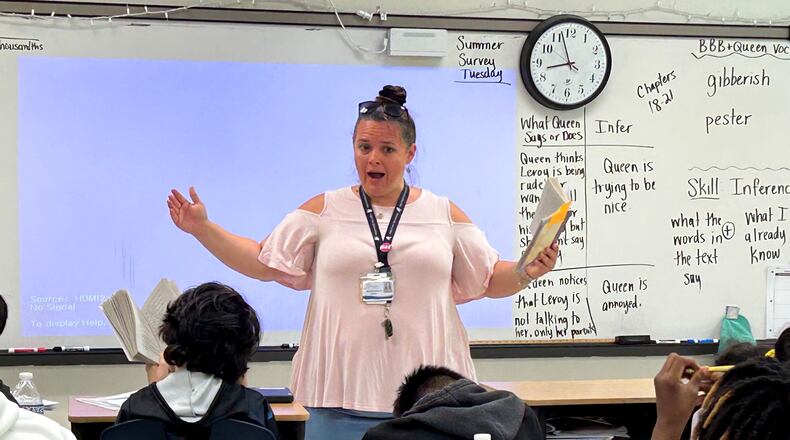Fifth grade teacher Jennifer Dallas walked around her classroom at Heards Ferry Elementary in Fulton County on a recent Tuesday, talking with her summer learning students. They were reading a book called “The Broken Bike Boy and the Queen of 33rd Street.” The main character, a 10-year-old named Queen, thinks she really is one and treats people accordingly.
Dallas was using the book to teach the students how to make inferences.
“What the words in the text say + What I already know,” she wrote.
“(The text) says Queen is walking backwards up the steps,” Dallas tells them. “Wasn’t she just running away down the steps? Why is she walking backwards up the steps now?”
Silence.
She pointed to the board. “Combine what you know with what’s happening and see if you can make an inference.”
They slowly start to answer.
Dallas is demonstrating how Fulton’s new literacy plan works. Because fifth graders don’t need basic instruction, such as sounding out words, she concentrates on comprehension. Fulton invested $90 million in federal pandemic relief money — about one-third of the district’s total — in a reading program it’s calling “Every Child Reads.” It’s possibly one of the largest investments by a school district nationwide in a reading initiative.
Many Fulton students fell behind academically when the pandemic disrupted schools in 2020. The slide was greater among students in the southern end of the county, but narrowed a bit once Fulton resumed in-person learning.
As schools tried to find ways to help kids catch up, the federal government also allocated unprecedented amounts of money to school districts.
“We knew we were going to have to do something transformational to regain where we were (before COVID-19),” said Clifford Jones, Fulton’s chief academic officer. “So that’s ultimately where this came into play.”
The plan centers around a body of research called “the science of reading.” Some teachers and administrators are required to undergo training that concentrates on features of reading including phonics (sounding out words), fluency, vocabulary and comprehension. On top of that, special education teachers are required to be trained in Lindamood-Bell, a program that individualizes learning based on a student’s particular needs.
Credit: Martha Dalton
Credit: Martha Dalton
All elementary school teachers are required to receive the two-year training program. The district pays them a total stipend of $2,300 to complete it. Some paraprofessionals and administrators will also be trained. Every elementary school has a literacy coach who provides support by working with groups of students or individuals. Middle and high school teachers who teach remedial reading classes will also be trained. Jones said so far, more than 2,500 teachers and 850 school leaders have started the training.
Jones said the idea is to create a “culture of literacy.” He and Fulton Superintendent Mike Looney have also completed the program. Before rolling out the new strategy, Jones said the district didn’t have a cohesive approach to reading instruction.
“We had — I don’t know — 15 to 20 different reading programs,” he said. “Every school was kind of doing it differently. Now we have a unified way to do this.”
The first cohort of teachers won’t finish the training until December, but they’re already applying what they’ve learned. Jocelynn McCullough, a special needs teacher at Heards Ferry, said she’s learned how to structure lessons to better help her students.
“When you’re reading, it’s like a ladder, you can’t miss a (step) or you’re going to fall off,” she said.
Laurie Carroll, Heards Ferry’s instructional support teacher, said the program focuses on small group and one-on-one instruction for students who are behind. She said that kind of intense teaching has yielded impressive results so far.
“(I’ve seen third and fourth grade) students who were starting off ... the school year on the kindergarten level, leaving that school year on the third grade level,” Carroll said.
Students in Fulton, the fourth-largest school district in Georgia, perform better on average than students in the state as a whole. Georgia Milestones Lexile scores from 2022 show about 64% of Georgia third graders were reading on or above grade level. In Fulton, 72% of third graders met or exceeded that standard. Educators consider third grade a critical year because that’s when students are expected to go from “learning to read” to “reading to learn.”
District officials are convinced the district is going to do even better. One of the goals is for 72% to eventually become 95%.
However, Jones cautioned that test scores won’t skyrocket overnight.
“You want to see steady, gradual ... progress over time,” he said. “And you want to see it for all (student) groups.”
Literacy in Georgia
Georgia students as a whole are underperforming on standardized tests that help measure literacy, which troubles many educators and state lawmakers. The Atlanta Journal-Constitution is taking a closer look at reading in Georgia’s schools this summer after lawmakers demanded a new approach to literacy.
About the Author
Keep Reading
The Latest
Featured



